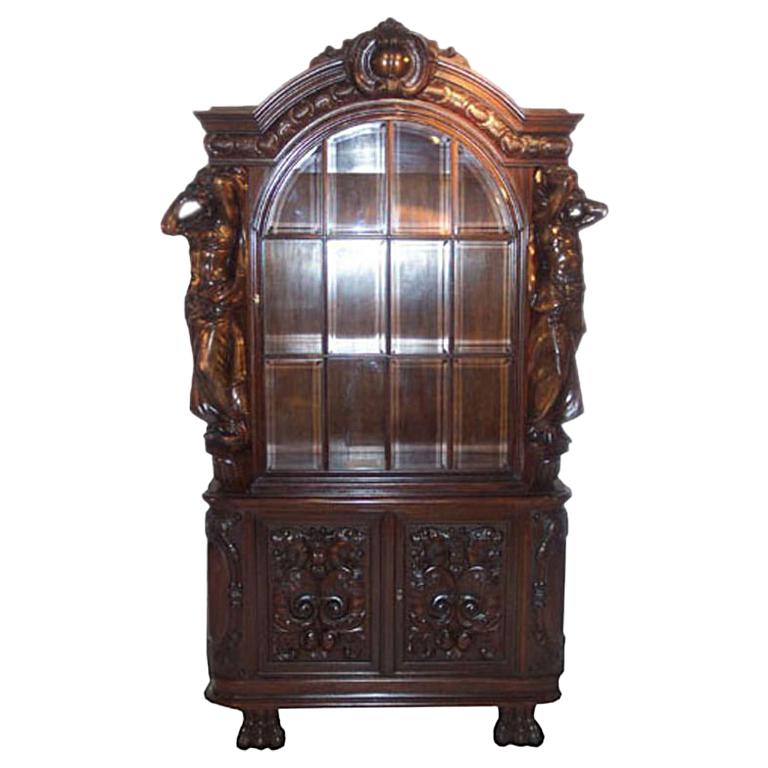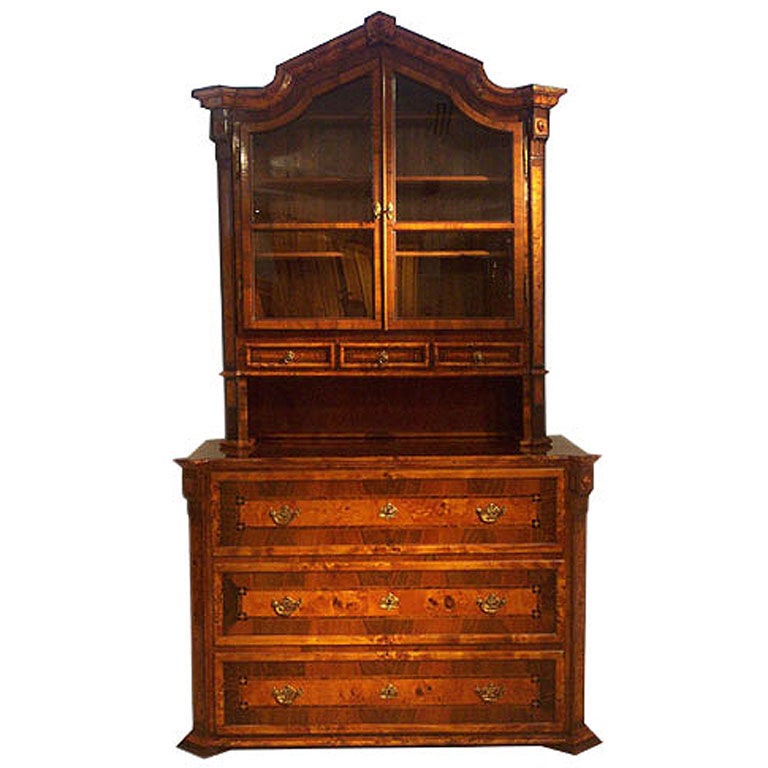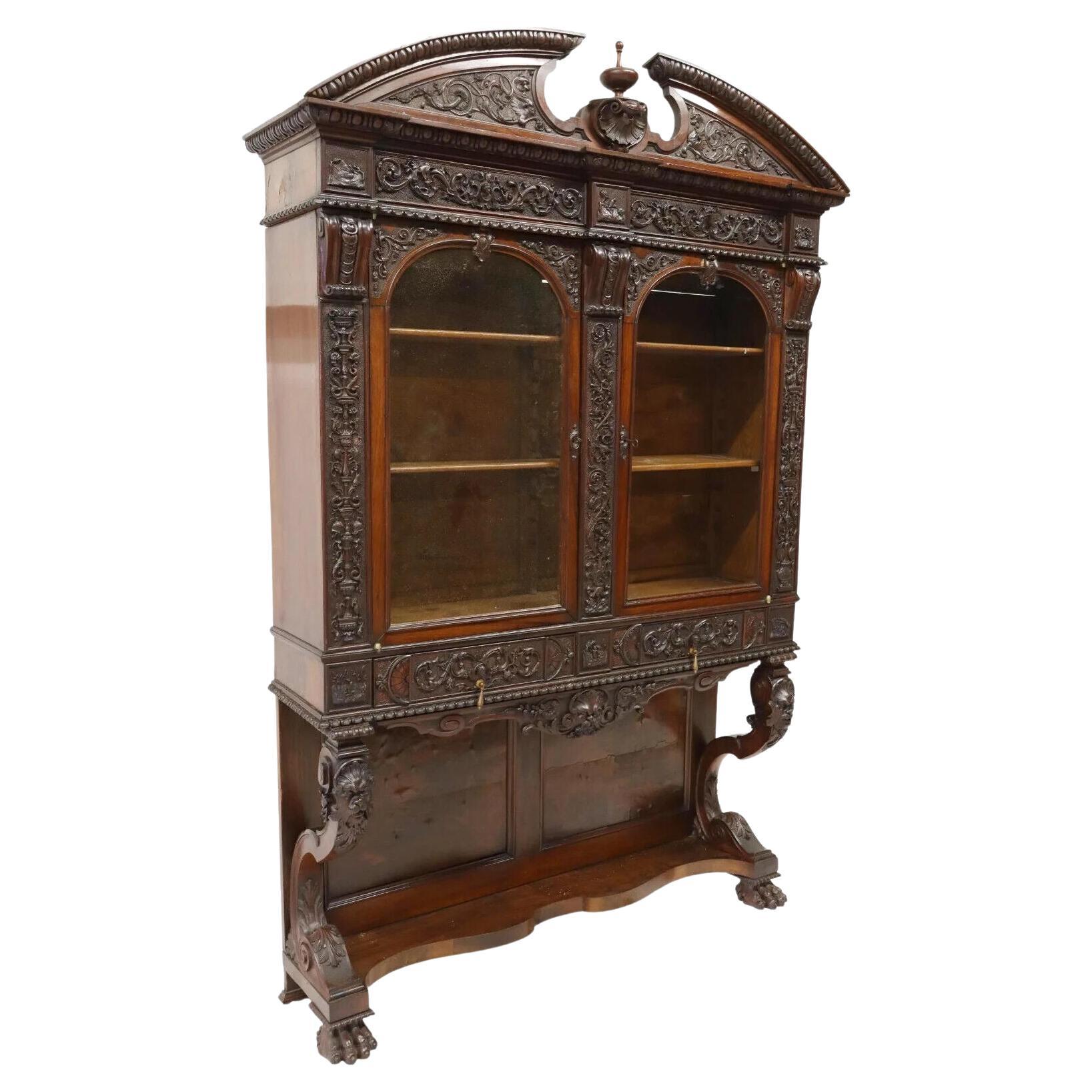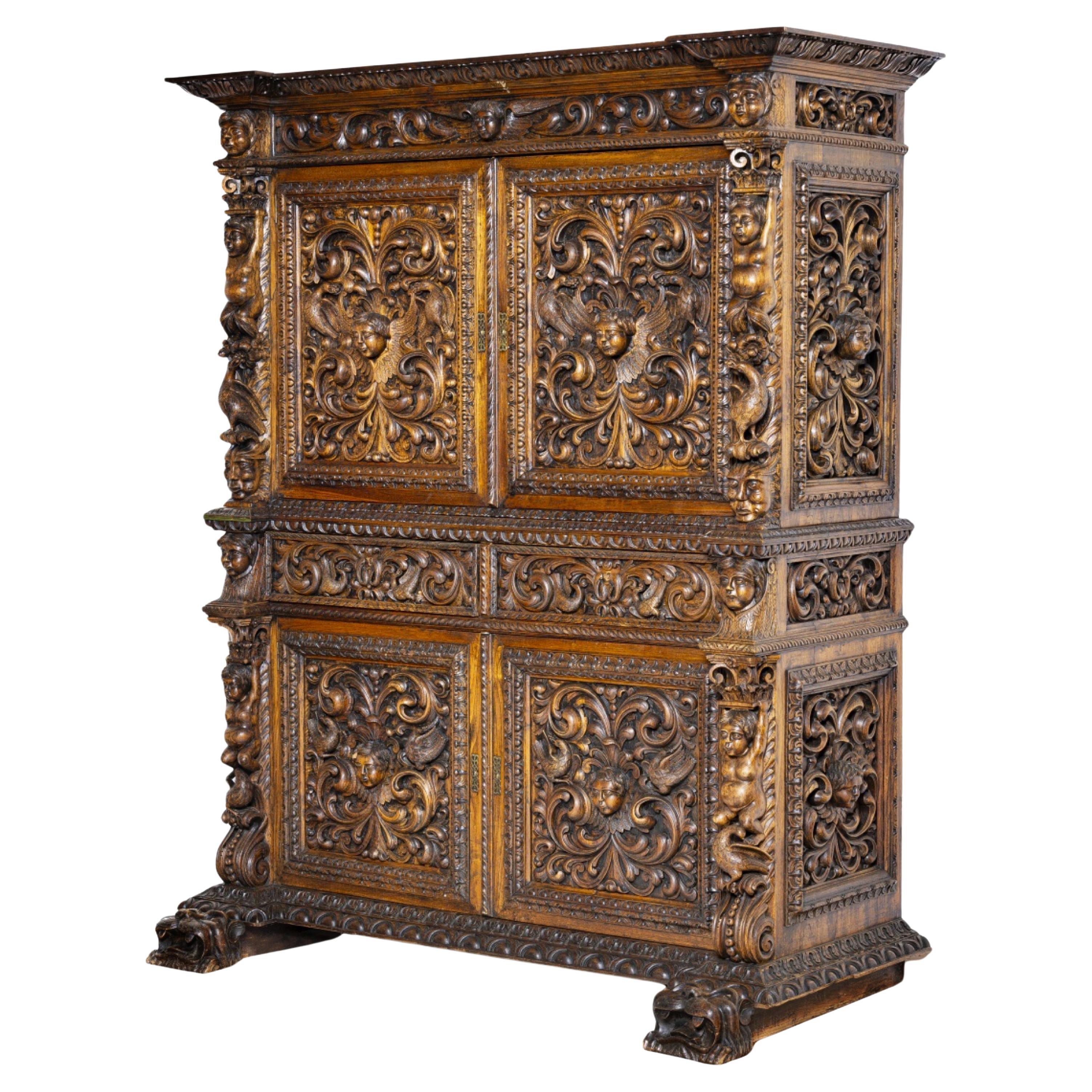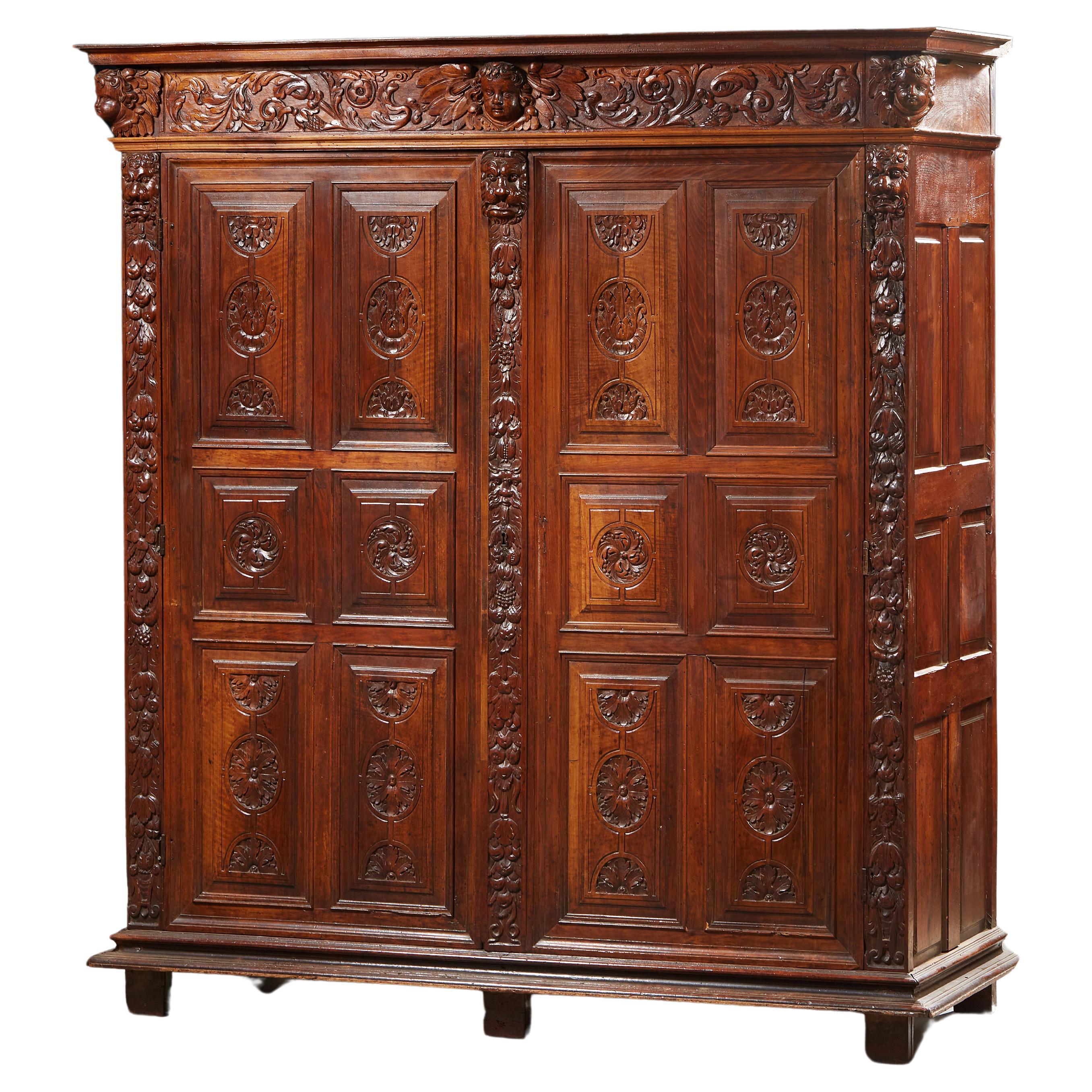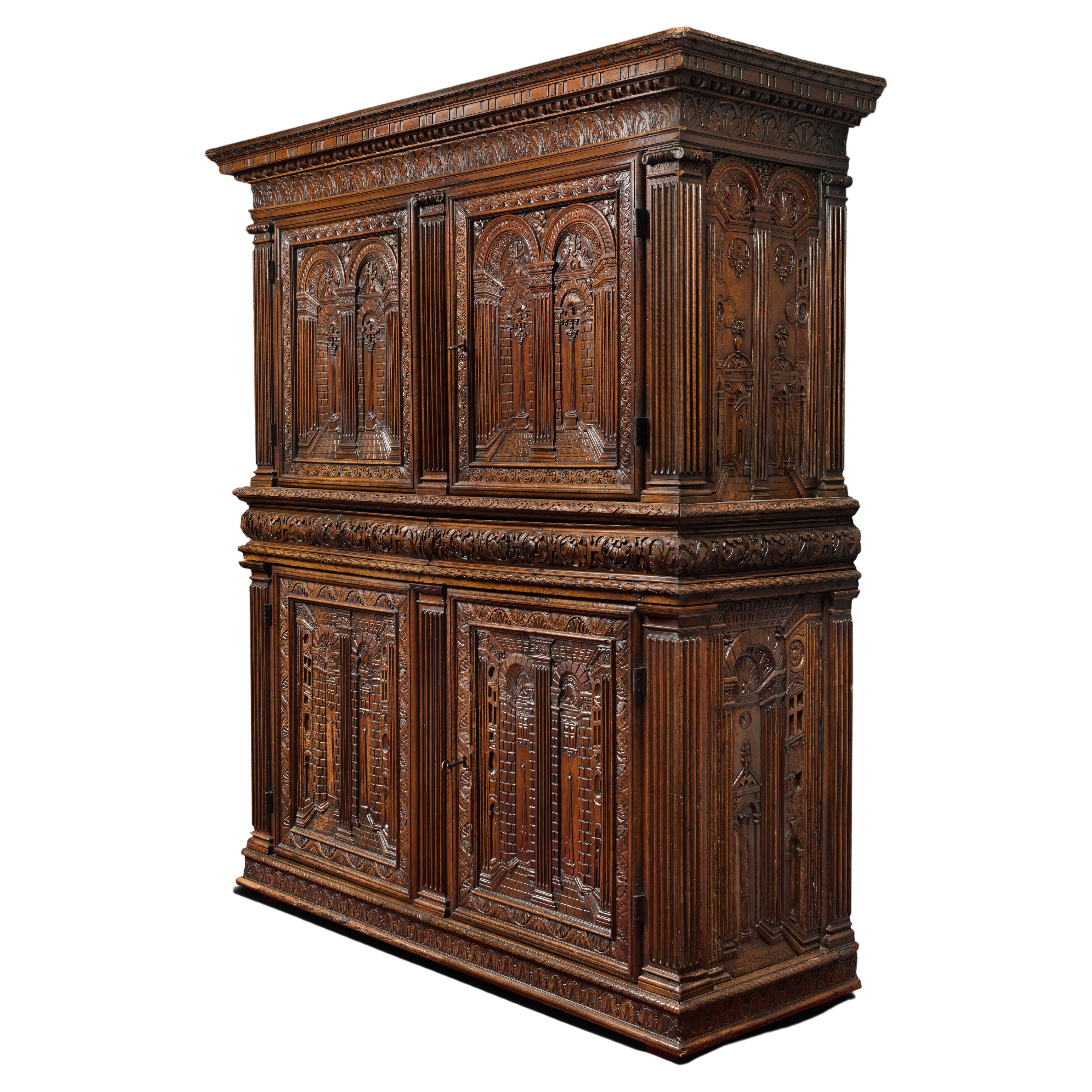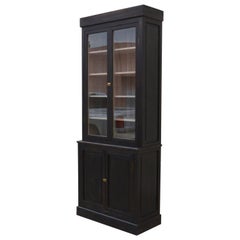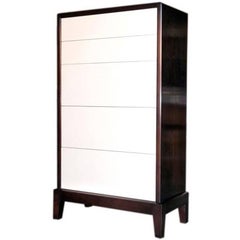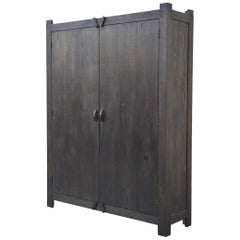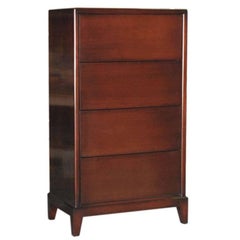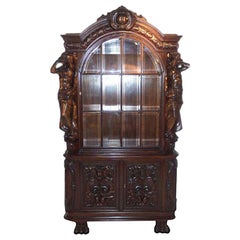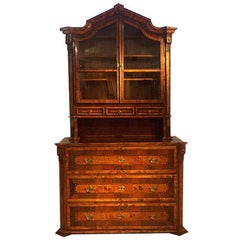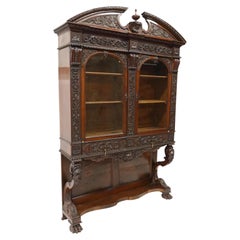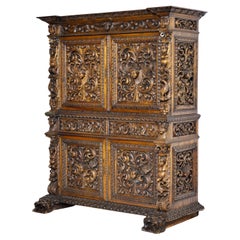Items Similar to Renaissance Style Vitrine Cabinet
Want more images or videos?
Request additional images or videos from the seller
1 of 11
Renaissance Style Vitrine Cabinet
$24,900
£18,815.45
€21,777.29
CA$34,933.48
A$38,856.04
CHF 20,383.83
MX$474,132.02
NOK 255,842.77
SEK 241,100.78
DKK 162,558.22
About the Item
This Renaissance style vitrine cabinet is a stunningly beautiful masterpiece in white oak with superb carvings and detail. Note the fourteen carved figures, lion's heads and other superbly carved adornments. "Anno" and "1566" are carved on scrolls just below the cornice, left and right of center. This date remains a mystery since this is definitely a 19th century masterpiece. All the hardware, joinery and locks are clearly mid-1800s. Perhaps it is a replacement piece or copy of an original from 1566. The style and quality of carving is typically Renaissance, not Renaissance Revival.
Upper cabinet has four doors with large glass panels. It is 114 x 50 x 17.5. Lower cabinet has four doors. It is 123 x 37 x 21.5. All the locks, hinges and latches are early-mid 19th century and are original to the piece.
Additional high resolution images are available upon request.
- Dimensions:Height: 87 in (220.98 cm)Width: 123 in (312.42 cm)Depth: 21.5 in (54.61 cm)
- Style:Renaissance (In the Style Of)
- Materials and Techniques:
- Place of Origin:
- Period:
- Date of Manufacture:19th Century
- Condition:Repaired: touch ups have been carried out. Wear consistent with age and use. Very few and tiny losses; minor wear.
- Seller Location:Los Angeles, CA
- Reference Number:Seller: RC21stDibs: U1109058065557
About the Seller
4.9
Gold Seller
Premium sellers maintaining a 4.3+ rating and 24-hour response times
Established in 1989
1stDibs seller since 2005
171 sales on 1stDibs
Typical response time: 2 hours
- ShippingRetrieving quote...Shipping from: Los Angeles, CA
- Return Policy
Authenticity Guarantee
In the unlikely event there’s an issue with an item’s authenticity, contact us within 1 year for a full refund. DetailsMoney-Back Guarantee
If your item is not as described, is damaged in transit, or does not arrive, contact us within 7 days for a full refund. Details24-Hour Cancellation
You have a 24-hour grace period in which to reconsider your purchase, with no questions asked.Vetted Professional Sellers
Our world-class sellers must adhere to strict standards for service and quality, maintaining the integrity of our listings.Price-Match Guarantee
If you find that a seller listed the same item for a lower price elsewhere, we’ll match it.Trusted Global Delivery
Our best-in-class carrier network provides specialized shipping options worldwide, including custom delivery.More From This Seller
View AllCustom Cabinet Made from Reclaimed Pine, Built to Order by Petersen Antiques
By Petersen Antiques
Located in Los Angeles, CA
This custom cabinet is made from reclaimed pine and comes with adjustable shelves. This listing is for one cabinet but can be bought as a pair
Because all of our pieces are bench-...
Category
2010s American American Craftsman Cupboards
Materials
Reclaimed Wood
Highboy Dresser or Chest of Drawers, by Petersen Antiques
By Petersen Antiques
Located in Los Angeles, CA
Highboy with five drawers in alder, dark walnut stain, ivory drawer fronts and premium satin lacquer finish (12 coats). This piece is inspired by an Italian design from the 1930s (se...
Category
2010s American Commodes and Chests of Drawers
Materials
Walnut
Rustic Cabinet in Reclaimed Heart Pine
By Petersen Antiques
Located in Los Angeles, CA
This rustic painted cabinet is made from reclaimed heart pine with adjustable shelves and planked doors. Seen here in 18" x 60" x 90", however i...
Category
2010s American Primitive Cabinets
Materials
Reclaimed Wood
$16,500 / item
Highboy Dresser/Chest of Drawers, by Petersen Antiques
By Petersen Antiques
Located in Los Angeles, CA
Highboy with four drawers in alder, dark walnut stain and premium satin lacquer finish.
The simple and clean look is achieved by using state of the art hardware that remains invisib...
Category
21st Century and Contemporary American Minimalist Commodes and Chests of...
Materials
Walnut
Tuscan Renaissance Style Dining Table, Custom-Made by Petersen Antiques
By Petersen Antiques
Located in Los Angeles, CA
This massive banquet table is very impressive, made in solid walnut with inlaid tiger maple. This table captures the feel of the Renaissance with its superb hand-carved legs, inlaid ...
Category
2010s American Renaissance Dining Room Tables
Materials
Walnut
Desk or Console Table Made from Rift Sawn Oak
By Petersen Antiques
Located in Los Angeles, CA
This rift sawn oak desk has turned legs and two drawers. It is seen here in 68" x 27" x 30" H, however it can be built in any size.
Because each tab...
Category
2010s American Desks and Writing Tables
Materials
Oak
$12,000 / item
You May Also Like
Neo Renaissance Vitrine
Located in Pompano Beach, FL
Solid oak, ornately carved. Large glass vitrine with interior shelves above 2 doors with interior shelves. Austro-Hungarian circa 1860/80. Part of ...
Category
Antique 19th Century Vitrines
$7,500 Sale Price
55% Off
Baroque Vitrine Zopf Style Vitrine/Cabinet
Located in Pompano Beach, FL
Top section with glass doors and interior shelves. Bottom section with three large drawers.
Category
Antique 19th Century Cabinets
Materials
Birdseye Maple, Ebony, Walnut
$16,500 Sale Price
66% Off
1800s Antique Renaissance Revival, Carved Display Cabinet / Vitrine
Located in Austin, TX
1800s Antique Renaissance Revival, Carved Display Cabinet / Vitrine
Beautiful Antique display cabinet, Vitrine, Renaissance Revival, ...
Category
Antique 19th Century European Renaissance Revival Sideboards
Materials
Wood
RENAISSANCE TWO BODY CABINET 19th Century
Located in Madrid, ES
RENAISSANCE TWO BODY CABINET 19th Century
In oak wood
Upper part with two profusely carved doors.
Lower part with two drawers and two doors.
Decorated with plant motifs, zoomorphic ...
Category
Antique 19th Century Portuguese Baroque Cabinets
Materials
Wood
$8,835 Sale Price
20% Off
Exceptional Cabinet known as the Sumene Cabinet
Located in Saint-Ouen, FR
EXCEPTIONAL CABINET KNOWN AS THE SUMÈNE CABINET
ORIGIN : FRANCE, NÎMES
PERIOD : 16th CENTURY
Height: 199 cm
Width: 180.5 cm
Depth: 69 cm
Walnut wood
Good state of preservation
...
Category
Antique 16th Century French Renaissance Cabinets
Materials
Wood, Walnut
Important Renaissance Cabinet from Lyon 'France' with a Decor of Perspectives
Located in Saint-Ouen, FR
As soon as 1540 France's second Renaissance is in the making, intimately linked to the rediscovery of the Antique world. The development of the printing and engraving industry allows the spread of artworks and models in many cities and countries. The Italian influence can be perceived in every artistic field. While the French king entrust the most talented Italian artists with major projects such as Il Rosso or Primaticcio in Fontainebleau, French artists also travel to Italy to form themselves to this new style. In Italy they get acquainted with the work of Leo Battista Alberti the first to theorize perspective (De Pictura, 1435-36) and architecture (De re oedificatoria, 1541). Those two publications would have a revolutionary impact on arts.
Furniture is marked by the work of the most famous Italian architects of the time as well as French architects. Indeed Philibert de l'Orme competes with Alberti and by the end of his life publishes several treaties including one devoted to a theory of architecture (1567). Unfortunately he would not live to complete the second volume. In this treaty he expresses his interest for mathematical norms applied to architecture, copied from the Antique. His journeys in Italy allowed him to accumulate the most sophisticated references. Jean Bullant, another architect of great talent also theorizes his practice. He establishes rules characterizing Greco-Roman art staying faithful to Vitruvius.
Following this new inspiration the structure of furniture evolves. From then on appear columns, capitals, cornices, friezes and architraves. The ornamentation uses this inspiration as well with egg-and-dart, palm leaf and rose adorning the most beautiful pieces.
In Lyon, crossroad where meet merchants from everywhere those new experiments are welcomed. Lyon florishing printing industry allows the spreading of models and treaties essential to the artist's work. Thus the first publication of Vitruvius' De Architectura in France would be printed in Lyon in 1532.
Artists from Lyon rediscover and familiarize themselves with the Antique knowledge very early. They adopt those new ideas and use them in their own creations. Lyon cabinet-makers re interpret Antique architecture and Italian Renaissance palaces to give their pieces a pure and harmonious architectural structure. Grooved pilasters are particularly favored. They are topped by capitals of diverse orders always respecting the sequencing with simpler ones for the lower levels and the richest ones on the higher levels. As for the ornamentation, one of the great distinctiveness of Lyon workshops remains the architectural perspective illusions, drawing inspiration from Tuscany.
True masterpiece of the Second French Renaissance this important cabinet illustrates Lyon workshops' taste for fine Italian architecture inspired by Antiquity. An architectural perspective of great quality is treated in symmetry on each panel.
This two-bodied cabinet without recess stands on four rectangular feet. The base comprises a molding, a palm leaf frieze and is bordered by a braid.
The lower body is divided by three grooved pilasters with Tuscan capitals framing two door-leaves. The two panels are encircled by a moudled frame with palm leaves. They are finely carved with a decor of fantasized architecture depicting an Italian Renaissance palace erected symmetrically on each side of a grooved pilaster. On the ground floor a door opens through a stilted arch while the stories are opened with mullioned windows, dormers and occuli. Two large pegged-boss cladded pillars support the entablature enriched by a palm leaf frieze upon which stands an arch whose coffered intrados is centred by a rose. Behind this arch a pyramid appears, standing in front of a second facade with a window topped by a broken curvilinear pediment under a cul-de-four with a shell.
The checker flooring gives depth to the low-reliefs creating vanishing points structuring the panels and guiding the eye of the observer.
A thin laurel braid highlights the belt of the cabinet where are located two drawers. Their facades are adorned by palm leaves in hoops.
The upper body is encircled with palm leaves. The same ternary division as in the lower body appears. However, the pilasters are topped by Ionic capitals with volutes and egg-and-dart. The door-leaves are framed with flowers. On the panels the artist has designed another architectural decor. On the foreground open two arches on top of grooved pilasters with rectangular capitals adorned with palm leaves. The arches are enriched with braids and the coffered intrados bears a decor of roses. The spandrels also bear a flower decor. In the background another arcature hosts a fluted grooved column topped with double basket acanthus capital, characteristic of Corinthian order. The triangular pediment is interrupted by a choux bourguignon.
A large cornice crowns the cabinet. It stands on pilasters and forms an entablature comprising a palm leaf frieze and an egg-and-dart, triglyph and palm leaf cornice.
The cabinet's sides have also been carefully considered. The lower body's panels are enriched with an arch rising above a broken pediment portico hosting a twisted column. Flowers garnish the spandrels. An architectural facade completes the decor. The upper body's panels present two arches supported by a facade opened with dormers and mullioned windows as well as cartouches (one bears the inscription 1580 dating the cabinet) suggesting the interior of an Italian Renaissance palace, confirmed by the chandeliers. The flooring leads our gaze to a second arch with a broken curvilinear pediment where stands a flower vase. This arch opens onto a perspective of another facade along a road.
Inside the cabinet, on the lower body door-leaves appear two designs. On the right door is depicted a Crucifixion. Saint Mary and Saint John flank the Christ on the cross. In the bottom part is inscribed « Dure uiator abis nihil haec spectacula curas / Pendenti cum sis unica cura Deo. / Tota suo moriente dolet natura Magistro. / Nil qui solus eras caussa dolenda doles. ». The signature [Christoff Swartz Monachiensis pinx[it] / Ioa[nnes] Sadeler sculp[it]] tells us it was made by Johan Sadeler I (1550-1600) after Christoph Schwartz (1548-1592). This engraving belongs to an ensemble depicting the Passion of Christ Johan Sadeler executed in 1589 after an altar piece painted by Christoph Schwartz for the private chapel of Renée of Loraine, wife of Duke William V of Bavaria. This altar piece made of nine copper panels has been destroyed during the 19th century. The Crucifixion panel once in the centre of the altar piece is the only one that survived and is today kept in Munich's Alte Pinakothek.
On the left door appears Saint Francis receiving the stigmata. The inscription says : « Signastidomine Servum Tuum. Franciscum. Signis Redemptionis Nostrae ».
This Renaissance cabinet with an architectural decor appearing as much in the structure faithful to Antique rules...
Category
Antique 16th Century European Renaissance Cabinets
Materials
Walnut
More Ways To Browse
Antique Renaissance Furniture
Carved Oak Italian Cabinet
Haberdashery Lighting
Quetzal Taxidermy
Vitrine By Jindrich Halabala
Weiman Curio
Design Institute Curio
Deguy French Art Deco 1935 Scnce Or Chandelier
50 Inches Or More Round Gold Mirror
Used Or Vintage Enamel Gold Charms
Vintage French Street Signs Or Numbers
Cane Or Rattan Furniture
Bamboo Or Rattan Furniture
Tall 72 Inches Or More Metal Sculpture
Aquamarine Platinum Or White Gold Rings
Gold Or White Gold Opal Eternity Rings
Antique Primative Armoire No Nails Or Screws Assembly Skeleton Key Two Drawer Base
Wrought Iron Dining Sets With Marble Or Granite Top
